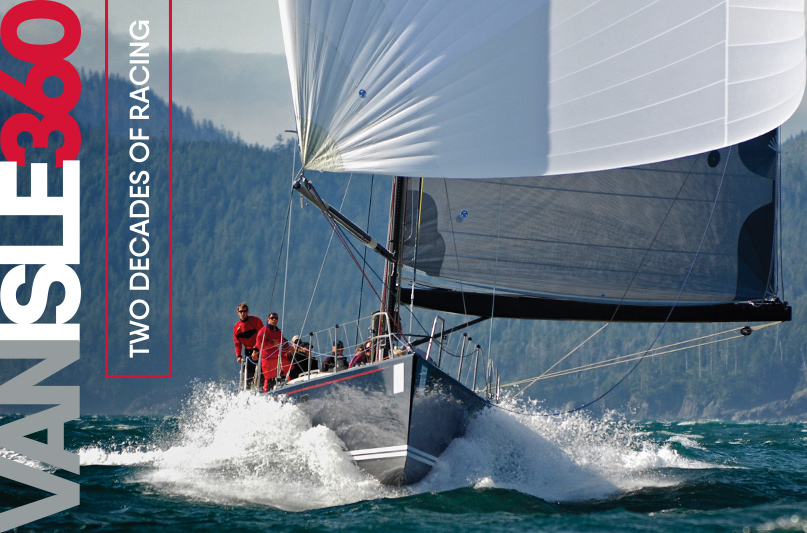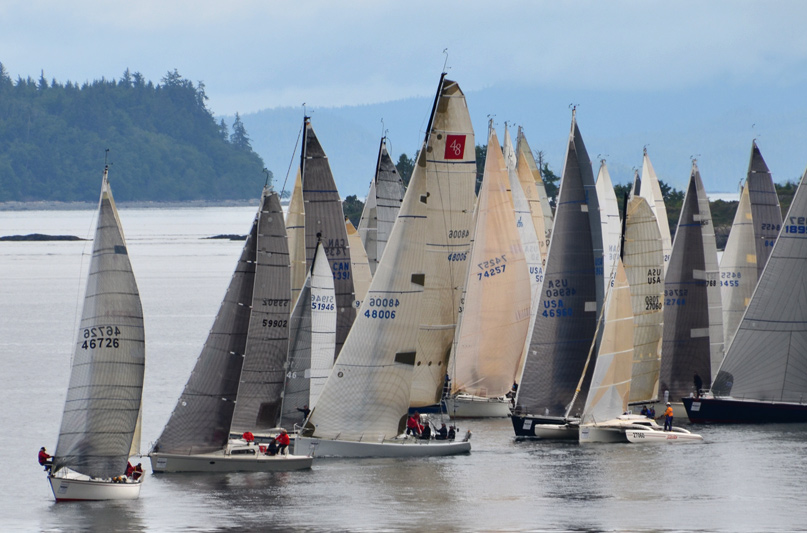
 Whether it’s timing the current through the Seymour Narrows, short tacking along the beach in Johnstone Strait while bears flip boulders for food on shore, or humpback whales guide the fleet into the mouth of the Strait of Juan De Fuca, sailing in the waters around Vancouver Island is a bucket-list experience. While being blown away by the setting, it can be easy to forget that the scenery is just the backdrop for some of the highest level of racing on the West Coast.
Whether it’s timing the current through the Seymour Narrows, short tacking along the beach in Johnstone Strait while bears flip boulders for food on shore, or humpback whales guide the fleet into the mouth of the Strait of Juan De Fuca, sailing in the waters around Vancouver Island is a bucket-list experience. While being blown away by the setting, it can be easy to forget that the scenery is just the backdrop for some of the highest level of racing on the West Coast.
Some come for the racing, others for the adventure, but what makes Van Isle 360 so special is that it is a sum greater than its parts. This race keeps boat owners and crews coming back year after year.
This summer, I will be racing with Steve Travis onboard his Transpac 52 (TP52) Smoke, romping our way around the island one more time. This will be my fourth Van Isle 360, having done two onboard Steve’s previous boat Flash and sailed on Smoke the last time the bi-annual race was held.
We’re ready to come out swinging this year in a close-knit fleet of very similar boats, all gunning for the line honors win. It is exactly what we have been working towards. Our core group has been together since the team’s first Van Isle in 2005, and we’ve added some great recent additions to round out the crew.
an Isle 360 began in 1999 with a race around Vancouver Island, partly for the competition, but mostly to see if it could be done. No one knew if a scheduled multi-stage event was even possible with the shifting winds and currents through the Inside Passage and the potentially dangerous offshore conditions down the outside.
An additional challenge was managing the logistical nightmare of the traveling circus of road crews and crew swapping in and out. Understandably, it had never been tried before.
The first race, nicknamed the Ambassador Race, was made possible by generous sponsorship; it was an instant success. The following two races were held back-to-back in 2000 and 2001, but after three years on the trot, many involved wondered if perhaps a biannual format was a better way to run the race going forward.

Above:Light air starts with close quarters, and flowing currents make working for clear air critical on the inside legs.
Blast Performance Sailing stepped in after 2001 and shifted it to the alternating-year schedule to give racing teams a break and keep sailors from burning out.
Now 20 years old, the race’s attendance ebbs and flows, but the level of competition is as high as ever. Thanks to the constant drive to increase the level of both competition and safety, Van Isle shows no sign of slowing down.
The general theme of the racecourse has remained the same for the past 20 years, i.e., keep Vancouver Island to port. The fun kicks off this year with the official skipper’s meeting in Nanaimo, with the start on June 1 in the harbor. From here, the fleet heads north through the Strait of Georgia to Comox, one of the longest inside legs, but the first so crews are fresh and ready to go.
The next morning, the fleet heads for Campbell River, often fighting heavy current, to arrive at the finish line off the pier in town. Next the fleet motors north through the infamous Seymour Narrows, with favorable current to the start line set in Deepwater Bay at the north end of the channel.
The leg from Deepwater Bay to the fish farm at Hardwick Island is closer to a bobsled run than a boat race, with the current pushing the boats towards the finish line. That night the fleet roughs it while rafted to a commercial fish farm. No provisioning is available, so crews deal with what they brought.
Leaving the fish farm, the fleet races to the historic town of Telegraph Cove and some much-needed showers and clean clothes. The marathon of racing continues with a sprint leg to Port Hardy, where racers finally get a break with a full lay day. This is both an opportunity to make repairs and swap out crew members before the infamous “outside” legs.
As the fleet begins to head south, the race takes on a different tempo. Longer legs and lay days bring on the endurance half of the race. The first of the outside legs takes the fleet over the top, rounding Cape Scott and beginning the run south in the Pacific Ocean to Winter Harbor.

Another lay day in Winter Harbor gives crews a chance to fully understand just how far off the beaten path they are, whether it’s waiting in line for the town phone or going for walks in groups to scare off bears. This remote fishing village always does its part to provide a bit of contrast to the frenzy of everyday life.
Back on the water, the race now turns into an endurance battle, with the long leg to Ucluelet clocking in at 140 miles. It’s worth noting that this goes down as the longest race in the region, without sailing to Hawaii or Alaska. Another lay day in Ucluelet to dry out the boat and allow everyone to finish the long leg brings with it the rude awakening of more than one store in town; the availability of cell service quickly brings the real world back into focus. From here, the fleet enters the familiar waters of the Strait of Juan de Fuca on the way to Victoria and the official return to civilization.
After a well-deserved dinner hosted by Royal Victoria Yacht Club, the fleet dials up on start line for the final time. The last leg to Nanaimo can make or break the overall standings as the fleet splits around islands, choosing either an inside route through the Gulf Islands or staying outside through Haro Strait. Coming into the finish is bittersweet for those wrapping up a two-week endurance vacation. It is time to get home and get back to work for some, while for others it feels like things were just getting started.
This year’s entry list is headed up by an impressive ORC 0 fleet, pitting some of the fastest boats in the Salish Sea against one another. No fewer than four Transpac 52s, the Santa Cruz 50 Surfrider, the J/160 Jam, and a rather impressively crewed Riptide 41 named Blue are all looking to take on this year’s course.
Steve Travis onboard his grey-hulled TP52 Smoke is no stranger to this race, with the team having taken part in every race since 2005. New to Van Isle 360 but far from inexperienced, John Buchan and his team onboard the dialed-in TP52 Glory are certainly going to be ones to watch, coming off last year’s dominating season and looking to put their name on another trophy.
Newcomer TP52 Sonic hit the ground running, taking part in the full season of races and not shying away from the competition, pulling into the docks with a hard-fought win in the Seattle Yacht Club’s Protection Island Race in boat-breaking conditions.
Also in the 52-foot group and sporting a new mast, Steve Johnson’s MIST is itching to stretch her legs after nearly a year off the water, awaiting her newly built mast. All in all, there is sure to be drama and close action on the water with such a competitive and evenly matched group battling around the island.
On the other end of the size spectrum, but taking things no less seriously, is Ian Loyde on the Grand Prix 26. No, that’s not a typo, a 26-foot boat is going to be racing around the island. Ian is no stranger to the race, having competed many times before on Raven, but this year he is taking things to another level with this pocket-sized racer.

Built as an offshore-capable sport boat, the GP26 may be the smallest boat in the fleet, but it’s far from the slowest, regularly holding pace with boats half again larger, surely a boat to keep a close eye on.
Those following the fleet should wisely track Michael Schoendorf’s Riptide 41 Blue, which is set to turn heads this summer. Sporting a water ballast and world-class crew of seriously experienced sailors, this team is a serious contender, especially in the second half with the longer offshore legs giving them a chance to stretch in the conditions the boat was born to sail. They are well situated to keep the big boats looking over their shoulders and the smaller boats working to keep up with the purpose-built offshore racing machine.
Meanwhile, there is a Canadian boat that is tough to ignore as well. The race-ready J/111 65 Red Roses II has a winning track record and a young but experienced crew looking to finish what they started two years ago. They are coming out with a bone to pick after losing their rudder in a high wind leg from Telegraph Cove to Port Hardy in the 2017 race. The team is fresh off a handicap win at Southern Straits, and it’s tough not to put money on the young team from Vancouver.

Of course, I’d be remiss not to talk shop about life as part of the Smoke crew. Rounding out the roster and keeping us all in check, Steve’s wife Suzanne manages the shoreside support and does a fine job of keeping the13 crew in line and on schedule.
This race is a coming together of many things both on and off the water, from boat deliveries to safety gear checks, and hotel reservations. No one thing is any less important than another. It literally takes a village (and a fish farm) to get one of these boats around the island. Often it is up to the crew to figure out how to keep things moving forward throughout the two-week ordeal with minimal resources and never much time.
Over the years, we have rebuilt transmissions in woodsheds, steering quadrants on docks, and boom goosenecks overnight, just to name a few. To say that this race has been a cornerstone of my adventures would not go far enough. Van Isle 360 has set the pace for much of my life and set the bar by which my experiences are measured against. As the days on the calendar get closer and the work list gets shorter, there is no doubt that this year’s Van Isle 360 is going to be one to remember.


